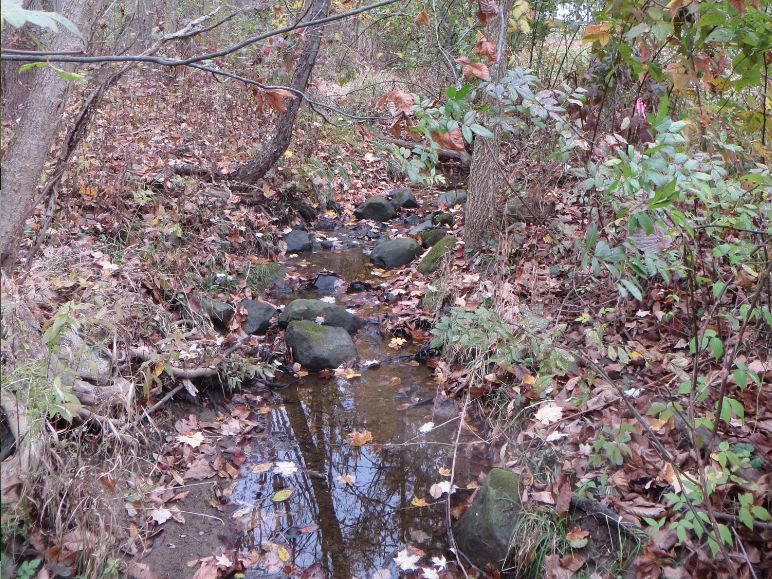FRY FARM IN RICHFIELD, OHIO
SIX AMPHIBIAN HABITATS
(CLICK ON LINKS BELOW)
 |
||||
Ohio boasts habitat diversity suitable for mainitaining a healthy amphibian fauna. It is convenient to divide amphibian habitats into terrestrial and aquatic, but it is critical to recognize that most amphibians live part of their life cycles in both aquatic and terrestrial habitats. "Thus it isn't sufficient to protect just one habitat type for a species to ensure its survival." 1) In other words, preserving just a spring or stream, without preserving the adjacent woods, will not result in an effective conservation plan. The Fry Farm has six identifiable amphibian habitats: pond, upland springs, headwater streams, marsh, forest and ephemeral pond. Pond Ponds are relativey stable, small bodies of water formed along streams, or fed by surface run-off and/or underground springs. Ponds surrounded by trees or heavy brush make the best habitat for amphibians, especially outside of the spring breeding season. The upland pond on Fry Farm is fed by surface water, and probably an underwater spring. It is not fed by any stream. The pond is surrounded by White Pines which benefits not only Grey Treefrogs, but also a loud chorus of Katydids in the Summer. It has also had the benefit of academic study. In 1994, Dr. Timothy O. Matson of the Cleveland Museum of Natural History came to the farm to study the Grey Treefrogs at the pond. That data, together with data collected throughout Ohio, formed an important data set for "Amphibians of Ohio," Ohio Biological Survey, Inc. (2013) Chapter 28, pp. 511-38, published nearly 20 years later. 2) The outflow from this pond ultimately flows into the Rocky River. Known amphibian species in this habitat on the Fry Farm include the Grey Treefrog, Peepers, Green Frog and American Bullfrog. Upland Springs Springs and seeps derive their water from underground aquifers and flow either under pressure or because the source is higher in elevation than the outfall. 3)
|
Upland springs originate near the upper end of a cove or ravine, compared to lowland springs which emerge from the base of a slope at the margin of a floodplain. 4) Springs often give rise to to small streams referred to as headwater streams. Headwater streams can flow year-round (permanent), for part of a year (intermittent) or only during rain events (ephemeral) 5) The two springs on the Fry Farm can be categorized as permanent upland springs. Known amphibian species in this habitat on the Fry Farm include the Northern Red Salamander and the Northern Two-lined Salamander. Streams The health of streams, particulary headwater streams, affects the health of creeks and rivers further downstream. They are important in sediment, nutrient, and flood control, serve as corridors for the movement of wildlife, and provide water and food for downstream communities. 6) Importantly, they provide a safe habitat for the preservation of species that may be damaged or destroyed by pollution or habitat removal further downstream. The two streams in the eastern portion of Fry Farm, the West and Middle Branch of the North Fork of Yellow Creek, are directly connected to the Medina Summit Land Conservancy via a 72 inch conduit under Interstate 271. Combining with other upland streams, they then flow through the Bath Nature Reserve in Bath, Ohio, the town of Yellow Creek, and ultimately, into the Cuyahoga River. Click here for Maps showing the connection between these streams, the Medina Summit Land Conservancy, and Subwatershed 38. Ephermeral Ponds Ephemeral ponds arise in poorly drained areas during rainy periods, particulary during the spring. It appears that amphibians use ephemeral habitats primarily for breeding. The life-span of these habitats are thus less important than timing on the part of the amphibian species that use them. 7) |
Known amphibian species in this habitat on the Fry Farm include the American Toad. Marsh A marsh is a permanent wetland with relative stability. A number of amphibians can be found in marshes, especially during the breeding season. 8) The marsh on the Fry Farm is fed by the two springs and a separate headwater stream. The head of the separate headwater stream that flows into the marsh is protected by a retention dam created when Rainbow Acres Subdivion was built and is located on land of that subdivision. There are thus two important mechnisms to help reduce downstream flooding on Yellow Creek: the retention dam and the marsh itself. Both require continuing protection. Forests Forests are habitats dominated by trees and other woody plants. They are important habitats for a wide variety of salamanders, toads and frogs during that part of the year when they leave the breeding habitats of streams and ponds. 8) Salamanders tend to do their hunting and mating journey across the forest floor during cool, wet nights of spring. During the day, and in the hot summer months, they are safely housed in crevices and small tunnels underground. They are also sometimes found under leaf litter, logs and flat stones. 9) On the Fry Farm, typical forest trees include Maple and Cherry, together with smaller numbers of Oak, Beech, Hickory and Tulip. The area between between the West and Middle Branches of the Upper North Fork of Yellow Creek is a potentially important forest habitat, but substantial recovery work must be accomplished since it had earlier been farmed for corn and hay. This area is now dominated by Autumn Olive and Multi-Flora Rose, both originally planted for conservation purposes, but now spread widely by birds and small mammals.
|
1. "Amphibians of Ohio," Ohio Biological Survey, Inc. (2013) p. 33. 2. E-mail correspondence from Timothy O. Matson to William L. Fry, dated Sep.9, 2008. 3. "Amphibians of Ohio," p. 43. | 4. "Amphibians of Ohio," pp. 399. 5. "Amphibians of Ohio," p. 43. 6. "Amphibians of Ohio," p. 43. | 7. "Amphibians of Ohio," p. 39. 8. "Amphibians of Ohio," p. 41, 43. 9. "Amphibians of Ohio," p. 64. |